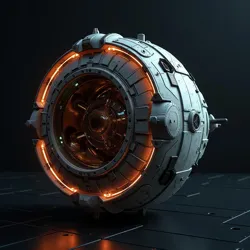Gravitic Maelstrom Generators
The Gravitic Maelstrom Generator represents one of the most devastating weapons systems employed by the Theocratic Navy, combining advanced gravitational manipulation technology with tactical battlefield control. Originally developed through collaboration between Elysian Gear Hierophants and the naval engineering corps, these massive devices create localized gravitational anomalies capable of tearing enemy fleets apart.
 The central containment sphere of a Gravitic Maelstrom Generator aboard a Purgator-class vessel
The central containment sphere of a Gravitic Maelstrom Generator aboard a Purgator-class vesselTechnical Overview
At the heart of each generator lies an artificially sustained gravitational singularity, carefully contained within multiple layers of gravitic shielding. The containment system allows precise control over the singularity's effects, enabling operators to direct and modulate the gravitational forces with unprecedented accuracy. When activated, the generator projects a rapidly expanding field of distorted spacetime that creates crushing gravitational forces, powerful enough to compress starship hulls and tear vessels apart.
The technology draws heavily upon the Elysians' mastery of gravitational manipulation, refined through centuries of development in their home galaxy of Uran. The generators require immense power supplies and specialized containment systems, making them too large for most vessels to carry effectively. This limitation led to the development of dedicated Gravitic Purgator vessels specifically designed to house and operate these weapons.
Tactical Applications
The Theocratic Navy employs Gravitic Maelstrom Generators primarily as formation-breaking weapons, using them to disrupt enemy fleet cohesion and create tactical advantages. When activated, the generators project gravitational vortices that pull enemy vessels out of formation, making them vulnerable to concentrated fire from other naval elements. The psychological impact of these weapons cannot be understated, as the sight of ships being crushed and torn apart by invisible forces often breaks enemy morale before the battle is fully joined.
Design Evolution
The current generation of Gravitic Maelstrom Generators represents the culmination of several major design iterations. Early prototypes proved unstable and dangerous to their own crews, leading to the development of enhanced containment protocols and safety systems. The breakthrough came when Grand Technarch of the Technate Idris Vorsen personally oversaw modifications to the containment matrices, incorporating elements of Elysian temple architecture into the generator housings to better channel and control the gravitational forces.
Strategic Impact
The introduction of Gravitic Maelstrom Generators has fundamentally altered void warfare tactics within the Theocracy's sphere of influence. Enemy fleets must maintain wider spacing between vessels, sacrificing concentrated firepower to avoid being caught in gravitational distortions. This tactical constraint has proven especially effective against aberrations, whose often chaotic attack patterns make them particularly vulnerable to the generators' effects.
Maintenance and Operation
Operating a Gravitic Maelstrom Generator requires extensive training and careful coordination between multiple crew departments. The Tech-Praetors who oversee these systems undergo specialized instruction in gravitational theory and practical containment protocols. Each generator requires a dedicated team of engineers and specialists working in concert to maintain stable operation, with backup crews standing ready to take control in case of emergency.
Safety Protocols
Given the devastating potential of malfunctioning generators, the Theocratic Navy maintains strict safety protocols governing their use. All Gravitic Purgator vessels must maintain minimum safe distances from friendly ships, and activation sequences include multiple redundant safeguards. Despite these precautions, several notable incidents during early deployment led to the implementation of enhanced containment systems and more rigorous crew training requirements.
See Also
- Gravitic Purgator
- Theocratic Navy
- Tech-Praetors
- Gravitational Vortices